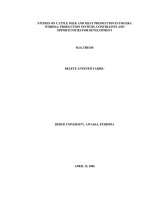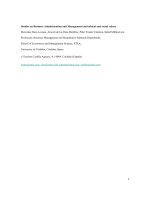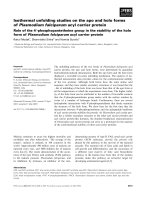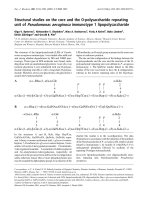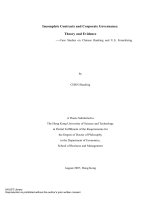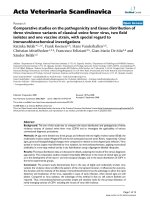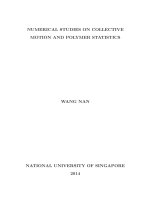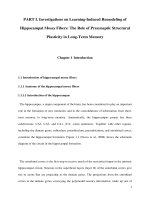Numerical studies on collective motion and polymer statistics
Bạn đang xem bản rút gọn của tài liệu. Xem và tải ngay bản đầy đủ của tài liệu tại đây (4.05 MB, 146 trang )
NUMERICAL STUDIES ON COLLECTIVE
MOTION AND POLYMER STATISTICS
WANG NAN
NATIONAL UNIVERSITY OF SINGAPORE
2014
NUMERICAL STUDIES ON COLLECTIVE
MOTION AND POLYMER STATISTICS
WANG NAN
(B.Sc.(Hons), National University of Singapore)
A THESIS SUBM I TTED
FOR THE DEGREE OF DOCTOR OF P HILOSOPHY
DEPARTMENT OF MATHEMATICS
NATIONAL UNIVERSITY OF SINGAPORE
2014
Acknowledgements
I would like to express my deepest appreciation to professor Bao Weizhu for his
inspiration, guidance and encouragement. He also gave me the chance and lead me
to the world of computational mathematics. Without his help, this thesis and many
others would not be possible.
I would like to thank Prof Pierre Degond and Prof Wang Zhisong for their support
and guidance during the collaboration. They provide constructive suggestions along
my r esearch.
I would like to thank my research fellows Ngoc and Hou Ruizheng for their
discussion and inspirations.
Special thanks are given to Zhao Xiaofei for helping me check the thesis.
I would also like to thank friends Yuan Zihong, Huang Mengmin, Jia Xiaowei,
Wang Yan and many others for their friendship and support.
Finally I would like to thank my parents and my wife for their understanding,
patience and love during the past several years.
i
Contents
Acknowledgements i
Summary v
List of Figures vii
1 Introduction 1
1.1 Problems . . . . . . . . . . . . . . . . . . . . . . . . . . . . . . . . . . 1
1.1.1 Collective motion . . . . . . . . . . . . . . . . . . . . . . . . . 1
1.1.2 Polymer statistics . . . . . . . . . . . . . . . . . . . . . . . . . 4
1.2 Scope and outline of the thesis . . . . . . . . . . . . . . . . . . . . . . 6
2 Models and Methods for Collective Motion of Particles 8
2.1 Existing models . . . . . . . . . . . . . . . . . . . . . . . . . . . . . . 8
2.2 Modified Vicsek model . . . . . . . . . . . . . . . . . . . . . . . . . . 11
2.2.1 Microscopic model and the mean field limit . . . . . . . . . . . 12
2.2.2 Scaling . . . . . . . . . . . . . . . . . . . . . . . . . . . . . . . 15
2.2.3 Hydrodynamic limit . . . . . . . . . . . . . . . . . . . . . . . 18
2.3 Particle model generated from Navier-Stokes system . . . . . . . . . . 31
2.3.1 Macroscopic model . . . . . . . . . . . . . . . . . . . . . . . . 31
ii
Contents iii
2.3.2 Scaling . . . . . . . . . . . . . . . . . . . . . . . . . . . . . . . 33
2.3.3 Particle method for fluid and microscopic model . . . . . . . . 34
2.4 Numerical methods . . . . . . . . . . . . . . . . . . . . . . . . . . . . 43
2.4.1 GPU parallelization . . . . . . . . . . . . . . . . . . . . . . . . 43
2.4.2 Numerical methods for microscopic modified Vicsek model . . 44
2.4.3 Numerical methods for the macroscopic model . . . . . . . . . 51
2.4.4 Numerical methods for particle model from the Navier-Stokes
system . . . . . . . . . . . . . . . . . . . . . . . . . . . . . . .
57
2.5 Numerical results . . . . . . . . . . . . . . . . . . . . . . . . . . . . . 60
2.5.1 Microscopice modified Vicsek model . . . . . . . . . . . . . . . 60
2.5.2 Comparison between the microscopic and macroscopic model . 61
2.5.3 Particle model from the Navier-Stokes system . . . . . . . . . 66
3 Models and Methods for Collective Motion of Polymers 68
3.1 Existing models . . . . . . . . . . . . . . . . . . . . . . . . . . . . . . 68
3.2 Self-propelling polymer model . . . . . . . . . . . . . . . . . . . . . . 70
3.2.1 Numerical methods . . . . . . . . . . . . . . . . . . . . . . . . 71
3.2.2 Numerical results . . . . . . . . . . . . . . . . . . . . . . . . . 74
3.3 Polymer fluid interaction . . . . . . . . . . . . . . . . . . . . . . . . . 74
3.3.1 Numerical methods . . . . . . . . . . . . . . . . . . . . . . . . 78
3.3.2 Numerical results . . . . . . . . . . . . . . . . . . . . . . . . . 80
4 Single Polymer Statist ic s 82
4.1 Existing models . . . . . . . . . . . . . . . . . . . . . . . . . . . . . . 84
4.2 Worm Like Chain model . . . . . . . . . . . . . . . . . . . . . . . . . 88
4.3 Methods for the WLC end to end distribution . . . . . . . . . . . . . 90
4.3.1 1D case . . . . . . . . . . . . . . . . . . . . . . . . . . . . . . 90
4.3.2 3D case . . . . . . . . . . . . . . . . . . . . . . . . . . . . . . 98
4.4 Numerical results and applications . . . . . . . . . . . . . . . . . . . 103
4.4.1 Single-polymer ‘flyfishing’ by a local alignment at one end . . 103
Contents iv
4.4.2 Single-polymer power stroke and intra- chain force transmission 106
4.4.3 Site-selective dissociation by intra-chain for ce . . . . . . . . . 108
4.4.4 New force-extension formula . . . . . . . . . . . . . . . . . . . 109
5 Conclusion and Future Persp ec tives 118
Bibliography 121
Summary
Mathematical models have been applied to various biological problems for a long
history, including the studies of populations, DNA sequences, pa t t ern formations and
protein st ructures. This thesis aims to study two areas in computational biology,
namely the collective motion and polymer statistics.
The first part of the thesis f ocuses on collective mot ion. Collective motion, or
flocking behaviour studies the common coordinated behaviour which is observed in
many scenarios. For example, animal society like schools of fish, herds of sheep,
swarm of locusts, and even a collection of micro-organisms like bacteria or sperms
perform collective motion. While individual may only react to their neighbours,
the overall structure obtained can be complex. It is therefore interesting to find
suitable particle int era ctio n rules. Models have been proposed in both microscopic
and macroscopic levels.
In this thesis, we begin with a review of microscopic models for particles. Dif-
ferent interaction rules and models have been proposed to match different senarios
with different complexity. We try to understand the link between micro models and
macro models. Two approches are used. The first one is a bottom-up approach.
We focus on the Vicsek model with repulsion. Starting for a mean-field descrip-
tion, we build a fluid limit or continuum limit to the system. The result is a set
v
Summary vi
of non-conservative hydrodynamic equations. Numerical schemes ar e pro posed and
the results for microscopic and macroscopic models are compared to validate the
derivation. The second one is a top-down approach. Starting from the fluid model,
we review particle methods for fluid simulation. We try to discretize the active fluid
model to particle level and yield an interaction rule knowing the global structure.
Furthermore, the simulation for a large system is achieved with the help of GPU
acceleration.
For micro-organisms living in fluid, volume exclusion effect and hydrodynamic
forces are important for the collective motion pattern formation. We simulate a
large system of rigid self-propelling rods. Extensive numerical simulations are per-
formed in rectangular, circular or annulus domains with different boundary con-
ditions, leading to different patterns. We then review some methods to simulate
particles in viscous fluids a nd t ry to understand the flow field generated by micro
swimmers.
The second part of the thesis deals with polymer statistics. Polymers are chains
made up with repeating units. For example, polymers include DNA, collagens, actin
filaments, microtubules and mot or proteins such as kinesin. We will review some
models used in polymer theory. The most popular model for semi-flexible polymer is
the worm like chain model. Despite its simplicity, it can model soft chains as well as
rigid rods. An understanding of the statistics of the worm like chain is the basics for
applications. After reviewing the existing polymer models, we use a path integral
approach to map the problem to a quantum rotor on a unit sphere to get the 3d
end to end distribution of the worm like chain. With t he distrubution a t hand, we
can get the force extension relationship and free energies of the chains with different
conformations.
List of Figures
1.1 A gallery of images related to collective motion . . . . . . . . . . . . 2
2.1 Three zone model . . . . . . . . . . . . . . . . . . . . . . . . . . . . . 11
2.2 Technical Circle . . . . . . . . . . . . . . . . . . . . . . . . . . . . . . 46
2.3 Illustration of Verlet table algorithm . . . . . . . . . . . . . . . . . . 48
2.4 Illustration of cell linked list algorithm . . . . . . . . . . . . . . . . . 49
2.5 Simulation for 2 ×10
4
particles at time T = 0, 0.5, 1.0, 3.0 respectively. 61
2.6 Simulation for 2 ×10
4
particles at time T = 1 with µ = 0 , 10, 100, 300
respectively. The initial orientation is randomized and the same ini-
tial data is used for all the tests. . . . . . . . . . . . . . . . . . . . . .
62
2.7 Relative error between the macroscopic and the microscopic model for
density (left) and θ (right) as a function of the numb er of averages for
different values of ǫ. The error decreases with both decreasing ǫ and
increasing number of averages, showing that the microscopic model
provides a valid approximation of the individual based model for ρ
and θ. . . . . . . . . . . . . . . . . . . . . . . . . . . . . . . . . . . .
64
vii
List of Figures viii
2.8 Solution of the Riemann problem along the x-axis for the macroscopic
model (blue line) and for the microscopic model with ǫ = 0.05 (red
line) at T = 1. . . . . . . . . . . . . . . . . . . . . . . . . . . . . . . .
65
2.9 Density ρ for the Green Taylor Problem at T = 0.6. Left:microscopic
model. Right:macroscopic model . . . . . . . . . . . . . . . . . . . . .
65
2.10 Mean orientation Ω for the Green Taylor Problem at T = 0.6. Left:microscopic
model. Right:macroscopic model . . . . . . . . . . . . . . . . . . . . .
66
2.11 Particle simulations in 2D domains. To p left: rectangle domain
L
x
= L
y
= 1 with periodic boundary condition. Top right: rect-
angle domain L
x
= L
y
= 1 with periodic boundary condition in x
direction and Neumann boundary condition in y direction. Bottom
left: circle domain, radius=1, Neumann boundary condition. Bottom
right: annulus domain, outer radius=1, inner radius=0.4, Neumann
boundary condition. . . . . . . . . . . . . . . . . . . . . . . . . . . .
67
3.1 Rigid rod simulations. Top left: 2D rectangle domain L
x
= L
y
= 1
with periodic boundary condition. Top right: 2D annulus domain,
outer radius=1, inner radius=0.3, repulsive boundary condition. Bot-
tom figures show the corresponding 3D domain with L
z
= 0.3. . . . .
75
3.2 Rigid rod simulations. Left: n=10, 600 rods, hig hly local alignment
observed for long rods. Right: n=4, 500 rods, alignment normal to
the boundary observed near the boundary. . . . . . . . . . . . . . . .
75
3.3 The mesh and streamlines for a ellipsoid particle. . . . . . . . . . . . 81
3.4 The interaction for 2 particles. They approach each other and align. . 81
4.1 The probability distribution integrated over a plane P (z). Left col-
umn: both ends are free. Middle column: the initial end is fixed along
the z axis. Right column: both ends are fixed along the z axis. . . . .
111
4.2 The probability distribution P (x, y, z) taken at different y planes for
different values of β, fixing l
c
= 1 . . . . . . . . . . . . . . . . . . . . 11 2
List of Figures ix
4.3 The probability distribution Q(z), energy F (z) and for ce f(z) for the
case l
p
= 4nm and l
c
= 10nm, with the starting direction being free
or make an angle θ with the z axis. . . . . . . . . . . . . . . . . . . .
113
4.4 The critical z where Q(z) reaches its maximum and the full width half
maximum for different θ where the starting vector ma kes an angle θ
with the z-axis. Here l
c
= 10nm and l
p
= 4nm. . . . . . . . . . . . . .
114
4.5 The critical z where Q(z) reaches its maximum and the full width
half maximum for different l
p
. . . . . . . . . . . . . . . . . . . . . .
114
4.6 The pr obability distribution Q(z) (blue curve) together with the Gauss
approximation for different l
p
. . . . . . . . . . . . . . . . . . . . . .
114
4.7 The energy difference ∆F for a chain with one end fixed along the z
axis. In the left figure, for each value of z, ∆F → ∆F
∗
as l
p
→ 0.
The dependence of ∆F
∗
on z is plotted in the right figure(blue curve).
The probability Q(z) can be well described by t he Gaussian function.
Taking l
p
→ 0, we can compute ∆F
Gauss
(z) = 0.30478z(green curve).
The energy difference agrees near z = 0nm. . . . . . . . . . . . . . . .
115
4.8 The force at z = −7nm and z = 7nm, for different θ . . . . . . . . . . 115
4.9 The comparison between the new fit formula and the force f(z) ob-
tained by numerical methods for different β. . . . . . . . . . . . . . .
116
4.10 The probability distribution, energy, force at position z = 5nm and
z = 8nm, for different l
p
. . . . . . . . . . . . . . . . . . . . . . . . . 117
Chapter 1
Introduction
1.1 Problems
1.1.1 Collective motion
Collective motion is a very common behaviour in nature. Many biological sys-
tems with different scales show the coherent motion of large number of individuals.
For example,a school of fish [21], a flock of birds [8 2]. The scale can be as large as
kilometers (herds of beasts) and can be as small as micrometers (bacteria) [
112].
In particular, we are interested in the collective motion of spermatozoa. Under
a phase contrast microscope, for a drop o f undiluted semen sample, we can observe
that millions of spermatozoa move together forming whirlpools and circular waves.
The collective phenomenon is termed massal motility. It is believed that the massal
motility is the only para meter which has a good correlation with male fertility,
but not the individual motility of a single spermatozoa. An understanding of the
collective motion can help us predict the semen fertility.
The study of collective behaviour has a long history and different approaches has
been taken. Different parameters describing the system can be extracted, including
density, polar ity, packing fraction and so on. Experiments are carried out to iden-
tify the collective motions. These include non-living systems(for example, shaken
1
1.1 Problems 2
(a) A herd of sheep (b) A flock of birds
(c) A school of fis h (d) A colony of bacteria
Figure 1.1: A gallery of images related to collective motion
metallic rods, simple robots, etc) [
110], macromolecules, bacteria colonies, cells [30],
insects, fish, birds, ma mmals and even human. The data collection techniques are
not discussed in details here.
In the mathematical point of view, different models ar e proposed, that rang e
from single par t icles to those with complex g eometries, and from microscopic level to
macroscopic level. The most simple form is the microscopic description of particles,
which ar e t ermed self-propelled part icles (SPP). The individual is described by its
position, velocity and orientation, and the main feature of collective mot ion is that
the individual behaviour is dominated by the influence of others. Exact rules for the
motion of each individual are defined, possibly with a noise term, which would then
yield a stochastic process. These rules are termed ”collision rules”, which describe
1.1 Problems 3
how individual would react to their neighbours. Based on the numerous o bservations
for different systems, the following hypotheses can be made abo ut collective motion:
the tendency to adopt the motion of the neighbours is the main reason for collective
motion, and there is a possible universal class of patterns since similar observations
can appear in very different orig ins.
Based on the observations, different collision rules are proposed. The first widely-
known flocking simulation was published by Reynolds in 1987, who just want to
visualize birds like flying objects, or ”boids”. Collision rules include alignment and
avoidance. After that, a statistical physics type of approach t o collect ive motion,
or the Vicsek model was introduced in 1995 by Vicsek. A random perturbation
of the direction is included in their system. A lot of research has been done by
varying some parameters or initial settings. The simulations exhibit a rich variety
of collective behaviours.
More sophisticated models consider individual agents not only as particles, but
with specific shape a nd volume. The shape selected depends o n the objects to be
modelled. To study the collective motion of micro-swimmers, since many bacteria
and sperms have elonga ted body, usually we consider them as polymers and use
hard rod o r linked beads to model them. The most simple model is the active
self-propelled particles in the paper of Baskaran and Marchetti. The particles are
basically asymmetric rigid dumbbells, where two spheres are connected with a in-
finitely rigid rod. Peruani simulated self propelled hard rods with a purely physical
mechanism. It is shown that the steric interaction due to volume exclusion leads to
the formation of moving clusters. Experiments with granular particles, i.e. artificial
self-propelled rods, have been performed to confirm that such a physical mechanism
is indeed enough to produce a variety of collective motion pattern.
Furthermore, for micro-organisms swimming in a fluid medium, the hydrody-
namics effect is oft en enough to generate a collective motion pattern, e.g., clusters,
vortices. Many works have been done to study the fluid mechanics. One of the first
general method for computing the hydrodynamic interactions among an suspension
1.1 Problems 4
of part icles was presented by Brady in 1988. Their method is actually the basis of
the Stokesian dynamics, a technique to study the velocity field for a particle system
in Stoke flow. Another approach, the so called slender-body theory was used by
Saintillan and Shelley to study the dynamics of self-propelled slender rods. Several
other different factors can be included in the bacteria model, including chemotaxis,
polarity and adhesion. It is still an open problem to get a realistic simple model to
capture the behaviour of micro-swimmers.
1.1.2 Polymer statistics
A polymer is a chain ma de of many repeating units, they are cr eat ed by polymer-
ization o f many small molecules, which is termed monomers. Examples of polymers
include the synthetic plastics such as polystyrene, as well as natural biopolymers
such as DNA and proteins. Due to the free rota t ions between the single bonds in
a polymer molecule, a single polymer molecule can have an enormous number of
different configurations, which are referred as polymer configurations. The difficulty
of a complete description of a single polymer configuration arises from the huge
number o f degree of freedoms, and we can see that the description of a single poly-
mer molecule is already a many body problem. However in real life experiments,
we cannot identify and measure a single polymer in molecular level, and we can
only consider some average over many different configurations. Thus we will study
polymer properties by means of statistic mechanics.
The study of polymer solution science started with the celebrated book by Flory
in 1953, where the concept of the excluded-volume effect was accepted. After that,
the study focused on flexible polymers within the Flory fr amework, which consists
the concept of Gaussian chain. If the chain length is decreased, then the stiffness
of the polymer becomes an important factor even for ordinary flexible chain poly-
mers as well as stiff or semi-flexible macromolecules such as DNA and the α-helical
polypeptides. In atomic level, the stiffness result in the hindrances to internal ro-
tations within the chain and other structural constraints. However, the details are
1.1 Problems 5
usually unnecessary to consider and cannot be treated easily. Therefore continuous
models were proposed. The first of them is the worm like chain model proposed by
Kratky and Porod in 1949 [
73]. Other modifications such as the helical worm like
chain were also developed later. Although the worm like chain model cannot mimic
exactly the dimensional behaviour of a real chain, it offers a rather good approxi-
mation for p olymers with a wide range of stiffness, and it acts as a fundamental tool
to predict the physical behaviour of many biopolymers. Examples include polymer
liquid crystals [
125], polyelectrolytes [50], protein networks and DNA molecules.
One of the key descriptor of the worm like chain statistics is the end to end
distribution function. For the Gaussian chain, the end to end distribution is well
known. However, it is not a trivial task to find the end to end distribution for a
worm like chain. Several studies have addressed the problem in different limits. In
the flexible limit, the cha in tends to a Gaussian chain, a nd the behaviour of finite
rigidity captures the fir st moments [
36]. In t he rigid rod limits, the chain statistics
are obtained using a path integral formulation with a fixed end orientation [
129].
Another approach for the rigid rod limit is evaluating the partition function by
summing over fluctuations about a nearly straight chain.
Beside the studies for the chain statistics, the exact end to end distribution is
only obtained in the last decade. Sever al different works tried different approaches.
One approach is a numerical study by direct diagolization of the truncated scatter-
ing matrix [
108]. A result for the end to end distribution in three dimensions in
Fourier-Laplace space (Fo ur ier-transformed end position and Laplace transfor med
chain length) was obtained using algebraic techniques [
117]. Another approach used
diagrammatic methods a nd got the chain statistics in Fourier-Laplace space in t he
form of infinite continued fractio ns [
113]. For the latter method, the statistical
behaviour in real space still requires an inversion from Fourier-Laplace space.
1.2 Scope and outline of the thesis 6
1.2 Scope and outline of the thesis
As shown in the previous sections, a large number of models have been proposed
to study the collective motion of a nimal societies. However, a model which can suc-
cessfully describ e the behaviour of spermatozoon is still missing. Most existing mi-
croscopic models will produce aggregation of par t icles and the formation of colonies,
while a suspension of sperms is a rather homogeneous solution. In chapter 2, we
try to understand the relationship between the individual motion and global fluid
like motion they can produce. Two approaches are used. The first is a bott om-up
approach. We will start with the Vicsek model and add repulsion between individ-
uals. Its hydrodynamic limit is derived to understand the glo bal structure of the
motion. The second approach make use of the particle methods for fluids. Knowing
the suspension behaves as an self-propelling active fluid, we can get a microscopic
model out of it. Different particle methods will be discussed. Numerical simulations
will be carried out to justify the derivation.
In chapter 3, we will move to more sophisticated mo dels for a better description
of the collective motion. By making use of GPU acceleration, we can model the
sperms as self propelling rods and take account of t he volume exclusion effect. We
will study how the shape of the rods and different boundary conditions can affect
the mot ion of the system. For more precise descriptions, we will also include the
hydrodynamic forces and try to understand the fluid particle interactions.
Chapter 4 then studies a single polymer statistics. We will review some famous
existing polymer models and then focus on the worm like chain model. Numerical
methods are propo sed to get the 3d end to end distributions with different end con-
formations. The results suggest the po ssibility of a surprising accurate flyfish-like
control in which tilting one end of a semiflexible polymer enables positioning of the
other diffusing end to a remote location within an error of 1nm. With the exact
statistics at hand, we can easily get the free energy and force-extension relat ionships.
A new force-extension formula that is valid for polymer with different rigidity is ob-
tained. The formula provides a convenient tool to estimate direction and magnitude
1.2 Scope and outline of the thesis 7
of intra-chain force, which are critical in site selective dissociation in nanomotors.
Finally the main results will be summarized in chapter 5. We will also address
some interesting topics for future works.
Chapter 2
Models and Methods for Collective Motion
of Particles
In this chapter, we study the collective motion of particles where each individual
is represented by a point and the shape of the object is no t co nsidered. We will firstly
review the existing models in the literat ur e. Then we will focus on selected models
and study them on both microscopic level and macroscopic level. Then accurate
and efficient numerical methods are proposed for the models for comparison.
2.1 Existing models
By our knowledge, Vicsek is the first in understanding collective motion [
122]. He
showed order-disorder phase transitions can be achieved using a simple model, which
is the discrete Vicsek model. The discrete Vicsek model considers N point particles
x
n
i
∈ R
3
at discrete times t
n
. Each particle has orientation ω
n
i
which belong s to the
unit sphere S
2
= {ω, |ω|
2
= 1} and velocity v
n
i
∈ R
3
. The system is updated in the
following manner.
v
n+1
i
= v
0
¯ω
n
i
+ perturbation, (2.1.1)
x
n+1
i
= x
n
i
+ v
n+1
i
. (2.1.2)
8
2.1 Existing models 9
Here ¯ω
n
i
represents an average or ientation of the neighbour particles near particle
i, and v
0
is the self-propulsion speed. Such particles are termed “self propulsion
particles”(SPP). Note that the interaction is short ranged. It is interesting that in
the limit v
0
goes to 0, the model becomes analogous to a classical Ising model in
the study of ferromagnet. One key finding of this model is that, as the number of
particles increase, there is a sharp phase transition from a disordered state to an
aligned state [
63], and this observation is confirmed using locusts [17]. Even without
an common qua dr atic Lyapunov function, the system is proved to be stable [
68].
Although the Vicsek model is not a very realistic model, it can be easily modified and
is applied in many areas due to its simplicity, examples include school o f fish [
49],
robotic swarms [7] and even human trails [57]. Variations for the Vicsek model
include changing symmetry, adding local cohesion and considering fluid [
23].
Another mo del which received great attention is propo sed by Cucker and Sma le
[
32]. Instead of interaction with the neighbours, each individual adjusts its velocity
as a weighted average of the whole population as follow:
v
n+1
i
− v
n
i
δt
=
λ
N
N
i=1
a
ij
(v
n
j
− v
n
i
).
Here a
ij
indicate the weight of how particle j will affect pa r ticle i. In [32], it is
defined as
a
ij
=
1
(1 + ||x
i
− x
j
||
2
)
β
.
for some β > 0.
Denote
Γ(x) =
1
2
i=j
||x
i
− x
j
||
2
and Λ(v) =
1
2
i=j
||v
i
− v
j
||
2
.
The main result in [
32] is that when β <
1
2
, the flock will converge to a constant
velocity unconditionally, where the initial configuration is not important. However
when β ≥
1
2
, the initial velocity and position have to satisfy certain compatible
conditions for collective b ehaviour. Another simple proof based on the explicit con-
struction of a Lyapunov functional can be found in [
55]. A remarkable application
2.1 Existing models 10
is that a spacecraft control law is designed based on the Cucker Smale model [99].
Similar as the Vicsek model, the Cucker Smale model can be easily modified. For ex-
ample, [
111] studies the emergent behavior under hierarchical leadership. [34] furt her
considered some random interactions.
Both Vicsek model and Cucker Smale model are “Individual Based Model(IBM)”
where the individual behaviour is studied based on the interaction with other in-
dividuals. Despite their success in modelling various fields, it becomes computa-
tional expensive and time consuming without parallel computing. Many works has
been done t o understand the models in macroscopic level. The statistic version of
the models are also call kinetic models. Kinetic model of the Vicsek model can
be found in [15, 16] while kinetic model of the Cucker Smale model can be found
in [
20]. It is interesting to see t hat the kinetic Cucker Smale model actually con-
verge to the kinetic Vicsek model [
18]. With an assumption of weak anisotropy of
the velocity distribution function, a hydrodynamic model of the Vicsek model is de-
rived [
10,11]. [103] offered another tr y to get a fluid model directly from the Vicsek
model. The first work which derives a fluid limit via the mean-field kinetic version
can be found in [
41]. They make use of the concept called the generalized collision
invariant(GCI). Further works can b e found in [38–40].
To build mor e realistic models, many models proposed in the biological literature
focus on three interaction rules between individuals. Basically they are repulsion,
alignment and attraction. When animals get too close, they will avoid each other.
When they are at intermediate distances they will try to align with each other.
Lastly when they will attract t hose who are very far away. These models are known
as three zone models [
5,29,67]. Different elements can be added into the three-zone
models depending on the species o f the animals. For example, the position of the
eyes of a bird is much different from those of a locust. And cone of visibility can
be taken into account for the interaction. Closed-neighbor interaction, noise and
other factors can also be considered. Other works include simulations considering
the speed change when joining or leaving a group [
54], avoiding predato r s [121] or
2.2 Modified Vicsek model 11
Figure 2.1: Three zone model
clustering when a predator approaches [
124]. With different parameters, different
zoology patterns are classified rather than a simple flocking behaviour, including
rotating single and double mills, rings and clumps [
33].
2.2 Mod ified Vicsek model
To understand the behaviour of a collection of sperm cells. The most simple
model considered would be the Vicsek model. In [
41], the hydrodynamic limit for
the Vicsek model is proposed. We will name this system as the Self-Organized
Hydrodynamic (SOH) model. To be precise, SOH model reads:
∂
t
ρ + c
1
v
0
∇
x
· (ρΩ) = 0, (2.2.1)
ρ∂
t
Ω + c
2
v
0
ρ(Ω ·∇
x
)Ω + v
0
dP
Ω
⊥ ∇
x
ρ = γP
Ω
⊥ ∆
x
(ρΩ), (2.2.2)
|Ω| = 1. (2.2.3)
Note that (
2.2.1) describes the conservation of mass, ( 2.2.2) controls t he orientation
which is the mean of neighbouring particles, and finally, (2.2.3) is a constraint term.
If (
2.2.3) is satisfied initially, it will be automatically satisfied for all times due to
the projection operator P
Ω
⊥ . Note that this system is similar as the Navier-Stokes
system in the sense that both contains a non-linear hyperbolic part f ollowed by
a diffusion term. The difference is that the moment um is not conserved in the
2.2 Modified Vicsek model 12
SOH model. Another important difference is that the convection velocities for the
density and the orientation, v
0
c
1
and v
0
c
2
are different while they are the same for
the Navier-Stokes system. As a consequence, the propagation of sound waves is
anisotropic for this type of fluids [
120].
Although the Vicsek model results in a fluid type system, it does not take con-
sideration of the volume exclusion effect and there could be a formation of very high
particle concentra tion. For a suspension of sperm cells, each is an elongated body
and the repulsion between each individual is imp ortant resulting in a rather homo-
geneous suspension. Therefore a more reasonable model would be adding repulsion
to the Vicsek model.
2.2.1 Microscopic model and the mean field limit
In the microscopic level, the model is stated as b elow.
dx
i
dt
= v
i
, (2.2.4)
dv
i
dt
= µ
1
(v
0
ω
i
− v
i
) +
µ
2
N
j
F
ij
, (2.2.5)
dω
i
= P
ω
⊥
i
(ν ¯ω
i
dt +
√
2DdB
t
+ αv
i
dt). (2.2.6)
Here (
2.2.4) simply describes the spatial motion of particle i with velocity v
i
. (2.2.5)
describes the force. The first term is a self pr opulsion force where each particle tends
to move towards its orientation ω
i
with a fixed speed v
0
, and the second term is a
repulsive force where F
ij
represents the pairwise interaction between particles i and
j. It can be written as F
ij
= −∇
x
φ(x
i
− x
j
). The support of the smooth potential
φ is a ball with radius r. µ is the mobility coefficient and N is the total number
of particles. Finally (
2.2.6) describes the time evolution of the orientation. Here
P
ω
⊥
i
= Id −ω
i
⊗ω
i
is the projection operator onto the orthogonal plane of ω
i
. Here
Id is the identity matrix and ⊗ represents the tensor product o f two vectors. This
projection operator ensures that ω
i
is always a unit vector.
The mean orientation ¯ω
i
is the mean orientation around particle i and is defined
2.2 Modified Vicsek model 13
as
¯ω
i
=
J
i
|J
i
|
, J
i
=
j
K(|x
i
− x
j
|)ω
j
. (2.2.7)
It is constructed in a way such that it is the normalization of the “total orientation”
J
i
, which sums up all the o r ientation vectors ω
j
within the observation kernel K,
which is the indicator function o f a ball centr ed at origin and with radius R.
The second term describes a white noise with intensity
√
2D. Note that the noise
here is against collective mo t ion thus competes with the first term. In 2-dimensional
space, the orientations belong to the unit circle S
1
and one can write ω = e
iθ
. In the
original version, a uniform noise in a small interval of angles [−a, a] can be added to
θ. In [
122], it is shown that there exists a threshold value a
∗
. For a < a
∗
, a coherent
dynamic structure is achieved while for a > a
∗
, the system becomes disordered at
all times.
The last term models the relaxation of the particle orient ation towards t he di-
rection of the particle velocity v
i
with rate α.
For a suspension of micro-swimmers in a fluid with very small Reynolds number,
we will consider the velocity in the overdamped regime. In (
2.2.5), we consider the
case when µ
1
goes to infinity and divide b oth sides by µ
1
, and let µ =
µ
2
µ
1
. The
system can be rewritten as
dx
i
dt
= v
i
, (2.2.8)
v
i
= v
0
ω
i
+
µ
N
j
F
ij
, (2.2.9)
dω
i
= P
ω
⊥
i
(ν ¯ω
i
dt +
√
2DdB
t
+ αv
i
dt). (2.2.10)
We now consider the mean-field kinetic equation which describes the time evolution
of the particle system in the large N limit. The unknown is a distribution function
which depends on the po sition x ∈ R
n
, orientation ω ∈ S
n−1
, as well as time t.
Note that in the overdamped regime, the velocity can be readily computed once the
orientation is determined. We consider the case without the Gaussian noise first.
